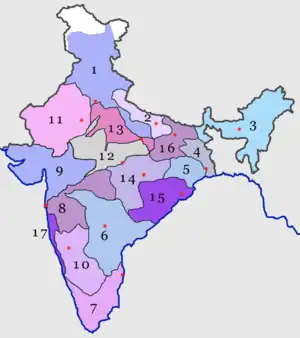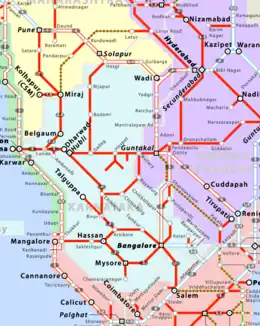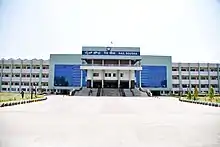South Western Railway zone
The South Western Railway (SWR) is one of the 19 railway zones in India, headquartered at Hubballi in Karnataka State. SWR was created from carving out the routes from Southern Railways, South Central Railways and Central Railways in 2003.
 | |
 10-South Western Railway | |
| Overview | |
|---|---|
| Headquarters | Rail Soudha, Gadag Road Hubballi Karnataka |
| Locale | Karnataka, Andhra Pradesh, Goa, Tamil Nadu and Maharashtra |
| Dates of operation | 2003– |
| Predecessor | Southern Railway zone South Central Railway zone Central Railway zone |
| Technical | |
| Track gauge | Broad gauge (1676mm, 5'6") |
| Previous gauge | Meter gauge |
| Electrification | 1,233 kilometres (766 mi) |
| Length | 3,566 kilometres (2,216 mi) |
| Other | |
| Website | www |
History
The South Western Railway zone came into existence on 1 April 2003 by bifurcating Mysuru and Bengaluru divisions from Southern Railway along with Hubballi division from South Central Railway. It is headquartered at Hubballi and comprises three divisions namely Hubballi, Mysuru, and Bengaluru. The fourth division at Kalaburagi was slated to be the fourth division which was supposed to be carved out from Hubli, Secunderabad, Guntakal and Solapur divisions. Currently the divisional office at Kalaburagi is on hold due to operational constraints.[1]
Jurisdiction

South Western Railway covers most of the railway lines in the state of Karnataka and Goa except the Konkan Railway line, parts of Sri Sathya Sai district and Chittoor district in Andhra Pradesh, Krishnagiri district, parts of Dharmapuri district and Tirupathur district of Tamil Nadu and parts of Sangli district and Solapur district of Maharashtra.
Divisions
- Bengaluru railway division
- Mysuru railway division
- Hubballi railway division
- Kalaburagi railway division (Proposed and on hold)
Development
As of 10 November 2021, out of 3,566 kilometres (2,216 mi) of broad gauge route, a total of 1,233 kilometres (766 mi) is electrified in the zone. [2]
The section between Bengaluru – Mysuru (136 kilometres (85 mi) is doubled and electrified. The bengaluru – Hubballi line doubling has been completed as of May 2023 and electrification of mainline has been completed till UBL whereas loop line electrification from stations between Haveri and hubballi are going on in fast pace and is expected to be completed by the month of June while Bengaluru – Tumakuru was doubled and opened to traffic in 2007. The doubling of the Birur – Chikjajur section of the same line was completed in 2015 while the doubling and electrification of Hubballi – Haveri section is in progress. The doubling of Yelahanka – Penukonda section has been completed till Hindupur and the remaining section is still in progress. The Ballari – Hubballi line is completely doubled and electrified. Gadag – Hotgi and Hubballi – Pune line (via Belagavi) doubling is in progress with electrification. In the 2016 Railway Budget, the electrification of Bengaluru – Salem line via Hosur and Dharmapuri was announced which was completed in July 2021. doubling between Baiyappanahalli and Hosur is in progress.[3] In February 2017, the Bengaluru – Hassan railway line via Shravanabelagola was completed.[4] Construction of new railway lines such as Tumakuru – Chitradurga, Chitradurga – Davanagere, Tumakuru – Kadiridevarapalli, Hubballi – Belagavi via Kittur, Yalvigi – Gadag, Gadag – Wadi, Ginigera – Raichur, Hubbali – Ankola, Miraj – Bagalkote, Hassan – Chikkamagaluru are either proposed, planned, under construction or partially open for service in phases.
Modernisation
The Mysuru Division of South Western Railways will be designated as "Digital Division" after fully adopting its current technology harnessing programme. The government of India had asked Railways divisions to cut red tape and reduce paperwork in offices. All the officials will adopt technologies like WhatsApp and Google Drive to share reports and other documents. This will save a lot of papers being used for circulating reports as done currently. Two web-based helplines have been launched so that digitised information can be shared among different officials. The inspection reports regarding maintenance, passenger amenities, cleanliness, electronics, and communication, etc. will be managed by a new software which is under construction now. These measures will cut down redundant works, reduce number of registers and reports maintained by officials, reduce paper consumption and improve the efficiency and celerity of operations.[5]
Project Unigauge
Since 2007, the SWR is entirely Indian gauge. SWR has 229 WDG4, 24 WAP-7, 62 WAG-9HC and WDP-4 locomotives in use.
Routes
Express routes
- No. 22691 / 22692 Bangalore–Hazrat Nizamuddin Rajdhani Express between Bangalore City railway Station and Hazrat Nizamuddin Railway station via GTL,SC
- No. 12649/50 Yesvantpur–Hazrat Nizamuddin Karnataka Sampark Kranti Express, between Yesvantpur Junction and Hazrat Nizamuddin Railway station via UBL,BAY,GTL,KCG
- No. 12627/28 KSR Bengaluru City-New Delhi Karnataka Express, between Bangalore City railway station and New Delhi railway station Via DMM,GTL,RC,SUR
- No. 12779/80 Vasco Da Gama-Hazrat Nizamuddin Goa Express, between Vasco Da Gama and Hazrat Nizamuddin Railway station
- No. 12027/28 KSR Bengaluru City-Chennai Central Shatabdi Express, between Bengaluru City railway station and Chennai Central railway station
- No. 12607/08 KSR Bengaluru City-Dr. PT MGR Chennai Central Lalbagh Express, between Bengaluru City railway station and Chennai Central railway station
- 20607/ 20608 MYS MAS Vande bharat express via SBC
- Yesvantpur–Kacheguda Express, between Yesvantpur Junction and Kacheguda
- Yesvantpur–Latur Express, between Yesvantpur Junction and Latur
- Rani Chennamma Express, between Bangalore City railway station and Miraj
- Yesvantpur–Shivamogga Town Express, between Yesvantpur Junction and Shivamogga Town
- Yesvantpur-Pandharpur Express, between Yesvantpur Junction and Pandharpur railway station
Loco sheds
- Diesel & Electric Loco Shed, Krishnarajapuram
- Diesel Loco Shed, Hubli
References
- "New railway division in Kalaburagi to be under SWR but they are not setting up as it is formed in Congress time". The Hindu. 6 March 2014. ISSN 0971-751X. Retrieved 25 December 2015.
- "South Western Railway completes electrification of 598 kilometres in 16 months". The Hindu. Retrieved 30 December 2021.
- "பெங்களூரு-தருமபுரி இடையே மின்சார ரயில் சேவை தொடக்கம்". Hindu Tamil Thisai (in Tamil). Retrieved 23 September 2022.
- "Bangalore - Hassan Railway line set for commissioning". The Hindu. Retrieved 22 February 2017.
- "On course to becoming a 'digital division' - Today's Paper". The Hindu. 18 September 2014. Retrieved 1 July 2016.
